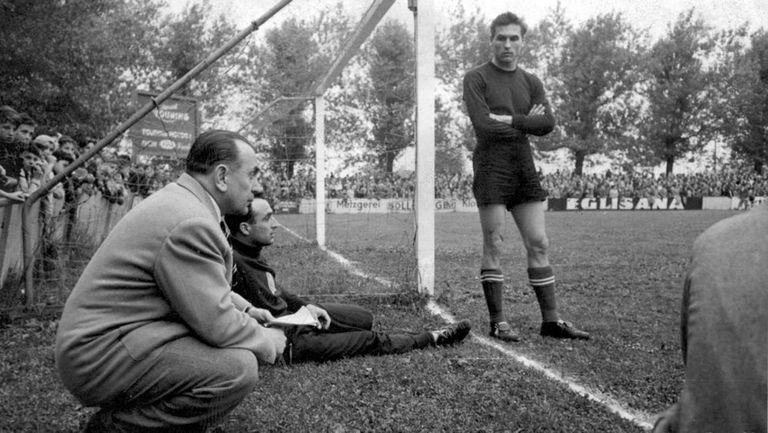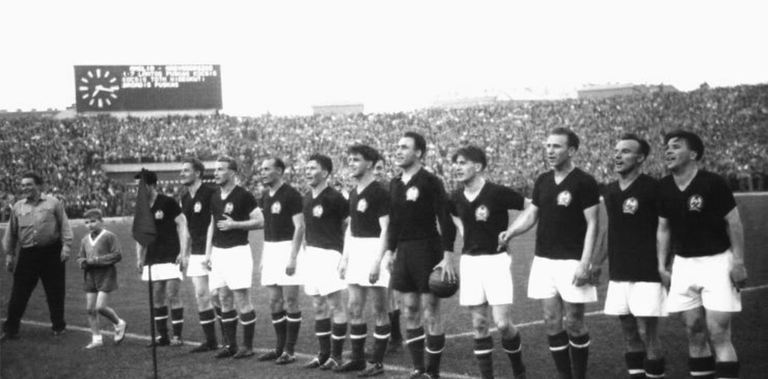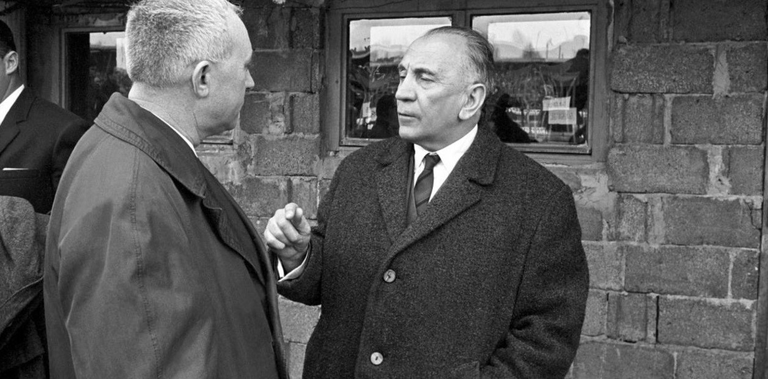
Sebes, the father of unrepeatable magicHe built the wonderful Hungary of the 50s and was one of the great coaches in history. An innovator in the field of tactics, he devised the system that Brazil later used in '70. Look at the dance that Hungary gave England at Wembley in 1953.
In the press center at the Soccer City stadium in Johannesburg, there were few journalists left and related. You could barely hear the murmur of the Mexicans who seemed to broadcast 24 hours a day even though their team was no longer in the competition. The next day, in the final against Holland, Spain would become world champion.
And the last talk among those who remained there, already in the early morning of South Africa, had to do with the decisive influence or not of Vicente del Bosque, the La Roja coach. And the dialogue moved to other influential technicians in history. Names paraded: Rinus Michels, Giovanni Trapattoni, José Mourinho, Johan Cruyff, Pep Guardiola. Others mentioned that the Menotti-Bilardo antinomy clearly defined the two ways of looking at football. So the talk was more like an argument that was then interrupted with amazement. Two Hungarian journalists who until then had only been listening threw a name and a surname on the table: "Gusztav Sebes." At first, there was silence. Immediately, a clarification: "The one from Hungary 54." Finally, everything was understood. And the back and forth continued for a while longer. And Sebes, who also won the gold medal with his team in Helsinki 1952, was there, 24 years after his death. Even though not everyone present knew him. Sebes was born in Budapest in the first decade of the 20th century. Son of a shoemaker, he learned three things from a very young age: that football was there for him to embrace, that nothing was achieved without effort and that collective victories are better than individual ones. His initial courts were made of sand. And they were for a long time until he became a First Division footballer. He trained in Hungary and played in France, where he also worked as an assembler in two automotive companies and participated actively in the union sphere. Then, upon his return, he stood out with the MTK shirt, with which he won four titles (three Leagues and one Cup). He was not the brightest star on the field, but he gave himself a treat that had been the first of his birthday wishes: in 1936, he played a game for the Hungarian national team. There was also a pasture atmosphere in the conception of that enormous spring of Hungarian football that he led, in the 1950s. Eva was the younger sister of Ferenc Puskas, the main star. He knew him well and once told about that childhood in the Hungarian capital: "He had a pleasure that he gave himself whenever he could: he would steal our mother's stockings and make rag balls to play with his friends." , with the neighbors.
He was an expert at that. For him it was almost an art." As in Sebes's time, there was sand in the uninhabited parts of the neighborhood. And there they played happily until darkness decided the end. István Cserjes - close friend of Puskas in childhood and later companion in Kispest - expressed in an interview on Hungarian television that, as a professional, Ocsi (as they called Ferenc) continued going to that space in Budapest where the best generation of Hungarian footballers in all of history was being born. The Hungarians' pasture was sandy, like the beaches of the Brazilian stars. Sebes knew that well-kept secret and he transferred it to the grass. The debut, at the 1952 Olympic Games, had been a luxury for football. those days and every day. In Finland, Hungary swept. The debut was with a certain timidity: against Romania, in Turku, they won 2-1. What continued was a storm: the 3-0 to Italy - then, now. two-time world champion and Olympic champion - was the perfect demonstration that this team was on the path to consecration. Already in the quarterfinals, the brilliance continued with goals: 7-1 to Türkiye. Sweden, the defending gold medalist, awaited in the semi-finals. He proved it again: Hungary was the best. He won by a tennis result: 6-0. And so they reached the final against Yugoslavia. Beyond his fidelity to the Communist Party, Sebes experienced rigor and discomfort.
On the night before the first big consecration match, he felt all the cold of Helsinki inside him. They say that a political leader told him five words that did not need further explanation: "Failure will not be tolerated." The interlocutor's gaze seemed oblivious to the enormous victory against Sweden in the semifinals. The coach was silent, listened, looked. And then, before his players, he invited them to do the same thing as always: to offer the best individual version in the name of collective construction. The history of the Olympic Games indicates that neither before nor after that final against Yugoslavia did a team play as well as those Magyars capable of doing magic without the need for tricks for ninety minutes without stopping.
It was a ballet in the service of success as well as a festival of play, a celebration of the playful nature of this sport. And also, a constellation: it had Ferenc Puskas, Sandor Kocsis, Zoltan Czibor and Nandor Hidegkuti, among other unforgettable figures. At the final, in the Olympic stadium in Helsinki, there were - according to official figures - 58,553 people to watch a group of talented people capable of reinventing football and a rival of those that no one wants to face due to the hierarchy of its members. Yugoslavia, which had been a finalist four years earlier, also stumbled against the Hungarians. Puskas and Czibor, in the final stretch of the match, guaranteed the 2-0 victory. The official summary of the competition offered by the organizers indicated the sporting significance: "This tournament saw the birth of one of the most brilliant squads in the world: Hungary, called the 'magical Magyars'." Sebes was the architect, the goldsmith and the engineer of that set of wonders. They recognized him as such. He was the leader; the voice that everyone heard and considered valid. "The uncle," they called him. His success allowed him to grow within the power structure of the country (he became vice minister of Sports and president of the Olympic Committee) and the continent (for six years he was vice president of UEFA). Grosics, a notable guarantee in that Hungarian bow, once said: "Sebes was very committed to socialist ideology, and that could be felt in everything he said. He made a political question about each important match or competition, and often spoke about how "The fight between capitalism and socialism was fought on the playing field like anywhere else." Sebes believed that talent should be at the service of everyone, that if one day someone failed the team should rescue them. He thus armed that Hungary that was capable of the best. Even establishing a before and after of its existence.
A year after the glory in Finland, that Hungary played a match that still lasts in the memories of those who saw it. And also in that of those who heard the legend of him. The Golden Team ("Aranycsapat", as the Hungarians called it) defeated England, at Wembley, 6-3, in what meant the first defeat for the home team in the most emblematic of their stadiums. FIFA, which places Sebes in the Hall of Fame, offers the following words to that episode: "If Sebes's political arguments led to their logical conclusion, it could also be said that the 1953 victory under the protection of the Towers Twins at Wembley was something of a revolution on a cold winter's afternoon as England were devastated to such an extent that the 6-3 scoreline did not fairly reflect the overwhelming Hungarian dominance, and both the tactics and technique of the visitors were left in disarray. the hosts helpless and their supporters in the stands paralyzed by perplexity. The Hungarians recorded 35 shots on goal against England's five, and their final goal, a volley from Hidegkuti, culminated a braided play made up of ten concatenated combinations. At that point, football surrendered at the feet of this memorable team. Sebes is also recognized as an innovator in the field of tactics: he inverted the traditional 3-2-5 formation (known as "The WM") and both Sebes' clubs and national team adopted what would be the beginning of the 4- 2-4 that the Brazil of its most glorious years would adapt to its conveniences and particularities.
Already in 1954, Hungary arrived at the World Cup with those unbeatable records: the gold medal and an undefeated streak of 31 games, with victories in several corners of Europe. Their initial tour in Switzerland consolidated the feeling of an unbeatable team: in the first leg they beat South Korea 9-0 and West Germany 8-3. Then they got rid of the two best teams from the previous World Cup, Brazil and Uruguay, in two memorable and controversial matches. The match with Brazil - an epic and arduous match - was referred to as "The Battle of Berne". Even Sebes ended up injured, with a cut on his face during one of the many encounters that at that time were not televised in detail. About the semi-final match against the Uruguayans, the English journalist Paul Gardner wrote: "They produced a magnificent affirmation of football as a sport." When remembering that epic day, Gerardo Bassorelli noted in the newspaper La República de Montevideo: "So many years of being undefeated in the World Cup ended at the feet of Kocsis, but, even though the setback has had a deep impact, to the point that some of "Our boys cried inconsolably in the locker room; time has made that defeat transform into the pride of the celestials and Magyars." Some called it "The Match of the Century." Each presentation by that team was very similar to a historical episode, to be kept in the memory of all time.
What happened next was one of the great surprises in the history of the World Cups. A kind of blow only comparable to the Maracanazo, which had happened four years before. The Hungarian magic lasted eight minutes in the final on July 4, again in Bern. With goals from Puskas and Czibor, the favorites won 2-0. Then, one of the most incredible feats began to happen: the same Germany that had been beaten in the first round, regrouped and won 3-2, with a goal from Max Morlock and two from Helmut Rahn, after an effort that They found all the grandiloquent adjectives to define it. That selection of Sepp Herberger was, in any case, the beginning of a truth sustained over time and in every relevant competition: never give up on the Germans. Even an inspiration for the phrase offered, half jokingly, half seriously, by the Englishman Gary Lineker: "Selected football is an eleven-against-eleven sport in which Germany always ends up winning": A film, "The Miracle of Berna", by Sonke Wortmann, portrayed that moment almost five decades later. It was a praise to the winners, but also the shadow of a tribute to Sebes who built that Golden Team capable of inhabiting all memories.
Hungarian football was never like that again. The prominence, in any case, continued in the 60s, almost as a tribute to the magical team: it won two consecutive gold medals, in the 1964 Tokyo Games (after beating Egypt 6-0 in the semifinals and winning 2-1 to Czechoslovakia in the final) and in Mexico 1968 (after beating Bulgaria 4-1 in the decisive match). In between, he stood on the podium at the 1964 Euro Cup, where he was only defeated by the local champion, Spain, in overtime. But little by little, it faded away. In 1986, Hungary played in the World Cup for the last time. Participation was a weak expression of the game and the results. The team was left out in the first round, after a victory against Canada and two rout losses, against France and the Soviet Union. Four months before the debut in Irapuato, Sebes died under the Budapest sky. And with him, it seems, the magic also died.

Armó la maravillosa Hungría de los años 50 y fue uno de los grandes entrenadores de la historia. Innovador en el terrero de las tácticas, ideó el sistema que luego usó el Brasil del 70. Mirá el baile que le dio Hungría a Inglaterra en Wembley en 1953.
En el centro de prensa del estadio Soccer City, en Johannesburgo, quedaban pocos periodistas y afines. Apenas se escuchaba el murmullo de los mexicanos que parecían transmitir las 24 horas aunque su seleccionado ya no estuviera en la competición. Al día siguiente, en la final ante Holanda, España se consagraría campeón del mundo.
Y la última charla entre los que quedaban allí, ya en la madrugada sudafricana, tenía que ver con la influencia decisiva o no de Vicente del Bosque, el entrenador de la Roja.
Y el diálogo se trasladó a otros técnicos influyentes de la historia. Desfilaron nombres: Rinus Michels, Giovanni Trapattoni, José Mourinho, Johan Cruyff, Pep Guardiola. Otros mencionaron que la antinomia Menotti-Bilardo definía claramente los dos modos de mirar el fútbol. Entonces, la charla se pareció más a una discusión que luego se interrumpió con un asombro. Dos periodistas húngaros que hasta ese momento sólo escuchaban lanzaron un nombre y un apellido sobre la mesa: "Gusztav Sebes".
Al principio, hubo un silencio. De inmediato, una aclaración: "El de Hungría 54". Al cabo, todo quedó entendido. Y el ida y vuelta continuó un rato más. Y Sebes, quien también ganó la medalla de oro con su equipo en Helsinki 1952, estaba allí, 24 años después de su fallecimiento. Incluso aunque no todos los presentes lo conocían.
Sebes nació en Budapest en la primera década del siglo XX. Hijo de un zapatero, aprendió tres cosas desde muy pequeño: que el fútbol estaba ahí para que él lo abrazara, que nada se conseguía sin esfuerzo y que las victorias colectivas son mejores que las individuales. Eran de arena sus canchas iniciales. Y lo fueron por un largo rato hasta que se transformó en futbolista de Primera.
Se formó en Hungría y jugó en Francia, donde además trabajó como montador en dos empresas automotrices y participó activamente en el ámbito sindical. Luego, ya de regreso, se destacó con la camiseta del MTK, con el que ganó cuatro títulos (tres Ligas y una Copa). No era la estrella que más brillaba en el campo, pero se dio un gusto que había sido el primero de sus deseos en varios de sus cumpleaños: en 1936, jugó un partido para el seleccionado húngaro.
También hubo ambiente de potrero en la concepción de aquella enorme primavera del fútbol húngaro que él condujo, en los años 50. Eva era la hermana menor de Ferenc Puskas, el principal crack. Lo conocía bien y alguna vez contó sobre aquella niñez en la capital húngara: "El tenía un gusto que se daba cada vez que podía: se robaba las medias de nuestra madre y armaba pelotas de trapo para jugar con sus amigos, con los vecinos.
Era un experto en eso. Para él era casi un arte". Como en los tiempos de Sebes, había arena en las partes deshabitadas del barrio. Y ahí jugaban encantados hasta que la oscuridad decidiera el final. István Cserjes -íntimo amigo de Puskas en la niñez y más tarde compañero en el Kispest- expresó en una entrevista a la televisión húngara que, ya como profesional, Ocsi (como le decían a Ferenc) seguía yendo a ese espacio de Budapest en el que estaba naciendo la mejor generación de futbolistas húngaros de toda la historia. El potrero de los húngaros era de arena, como las playas de los cracks brasileños. Sebes conocía ese secreto tan bien guardado. Y lo trasladó al césped.
La presentación en sociedad, en los Juegos Olímpicos de 1952, había sido un lujo para el fútbol de esos días y de todos los días. En Finlandia, Hungría arrasó. El debut fue con cierta timidez: ante Rumania, en Turku, se impusieron 2-1. Lo que continuó fue un vendaval: el 3-0 a Italia -entonces, ya bicampeón mundial y campeón olímpico- resultó la perfecta demostración de que ese equipo iba tras los pasos de la consagración. Ya en cuartos de final, el lucimiento continuó con goles: 7-1 a Turquía. En las semifinales esperaba Suecia, el defensor de la medalla dorada. Lo volvió a demostrar: Hungría era el mejor. Se impuso por un resultado propio del tenis: 6-0. Y así llegó a la final ante Yugoslavia.
Más allá de su fidelidad con el Partido Comunista, Sebes conoció de rigores y de incomodidades.
En la noche previa al primer gran partido consagratorio, sintió todo el frío de Helsinki dentro suyo. Cuentan que un dirigente político le dijo cinco palabras que no necesitaban explicaciones posteriores: "No se tolerará el fracaso". La mirada del interlocutor parecía ajena a la enorme victoria ante Suecia en las semifinales. El entrenador hizo silencio, escuchó, miró. Y luego, ante sus jugadores, invitó a lo de siempre: a ofrecer la mejor versión individual en nombre de la construcción colectiva. La historia de los Juegos Olímpicos señala que ni antes ni después de aquella final frente a Yugoslavia un equipo jugó tan bien como esos magyares capaces de hacer magia sin necesidad de trucos durante noventa minutos sin parar.
Era un ballet al servicio del éxito además de un festival de juego, una celebración del carácter lúdico de este deporte. Y también, una constelación: contaba con Ferenc Puskas, Sandor Kocsis, Zoltan Czibor y Nandor Hidegkuti, entre otras figuras sin olvido. A la final, en el estadio Olímpico de Helsinki, fueron -según cifras oficiales- 58.553 personas para observar a un grupo de talentosos capaces de reinventar el fútbol y a un rival de esos que nadie quiere enfrentar por la jerarquía de sus integrantes. Yugoslavia, que había sido finalista cuatro años antes, también tropezó ante los húngaros. Puskas y Czibor, en el último tramo del encuentro, garantizaron la victoria 2-0. El resumen oficial de la competición ofrecido por los organizadores indicó el significado deportivo: "Este torneo vio el nacimiento de una de las escuadras más brillantes del mundo: Hungría, llamada los 'mágicos magiares'".
Sebes fue el arquitecto, el orfebre y el ingeniero de aquel conjunto de maravillas. Lo reconocían sus dirigidos como tal. Era el líder; la voz que todos escuchaban y daban por válida. "El tío", le decían. Su éxito le permitió crecer dentro de la estructura de poder del país (llegó a ser viceministro de Deportes y presidente del Comité Olímpico) y del continente (durante seis años fue vicepresidente de la UEFA). Grosics, notable garantía en aquel arco húngaro, contó alguna vez: "Sebes estaba muy comprometido con la ideología socialista, y eso se podía palpar en todo lo que decía. De cada partido o competición importante hacía una cuestión política, y a menudo hablaba de cómo la lucha entre el capitalismo y el socialismo se libraba en el terreno de juego como en cualquier otro sitio". Sebes creía que el talento debía estar al servicio de todos, que si algún día alguien fallaba el equipo debía rescatarlo. Así armó a aquella Hungría que era capaz de lo mejor. Incluso de establecer un antes y un después de su existencia.
Un año después de la gloria en Finlandia, esa Hungría disputó un partido que todavía dura en la memoria de los que lo vieron. Y también en la de los que escucharon su leyenda. El Equipo de Oro ("Aranycsapat", como lo llamaban los húngaros) venció a Inglaterra, en Wembley, por 6-3, en lo que significó la primera caída para los dueños de casa en el más emblemático de sus estadios. La FIFA, que lo ubica a Sebes en el Hall of Fame, le ofrece las siguientes palabras a aquel episodio: "Si los argumentos políticos de Sebes desembocaron en su conclusión lógica, también se podría decir que la victoria de 1953 al amparo de las Torres Gemelas de Wembley fue algo parecido a la revolución en una fría tarde de invierno. Inglaterra fue devastada de tal manera que el marcador de 6-3 no reflejó con justicia el abrumador dominio húngaro, y tanto la táctica como la técnica de los visitantes dejaron a los anfitriones impotentes y a sus seguidores en las gradas paralizados por la perplejidad. Los húngaros registraron 35 disparos a puerta contra cinco de Inglaterra, y su gol definitivo, una volea de Hidegkuti, culminó una jugada trenzada compuesta por diez combinaciones concatenadas". A esa altura, el fútbol se rendía a los pies de este equipo memorable. Sebes es también reconocido como un innovador en el ámbito de las tácticas: invirtió la tradicional formación 3-2-5 (conocida como "La WM") y tanto los clubes como la selección de Sebes adoptaron el que sería el comienzo del sistema 4-2-4 que el Brasil de sus años más gloriosos adaptaría a sus conveniencias y particularidades.
Ya en 1954, Hungría llegó a la Copa del Mundo con esos antecedentes inmejorables: la medalla de oro y una racha invicta de 31 partidos, con goleadas por varios de los rincones de Europa. Su recorrido inicial en Suiza consolidó la sensación de equipo imbatible: en el primer tramo goleó 9-0 a Corea del Sur y 8-3 a Alemania Federal. Luego se sacó de encima a los dos mejores del Mundial anterior, Brasil y Uruguay, en dos partidos memorables y polémicos. A la cita con Brasil -partido épico y arduo- se la refirió como "La Batalla de Berna". Hasta Sebes terminó herido, con un corte en la cara durante uno de los tantos entreveros que en ese tiempo no se televisaban en detalle. Sobre el encuentro semifinal contra los uruguayos, el periodista inglés Paul Gardner escribió: "Produjeron una magnífica afirmación del fútbol como deporte". Al momento de recordar aquella jornada épica, Gerardo Bassorelli señaló en el diario La República de Montevideo: "Tantos años de invicto en Mundiales acabaron en los pies de Kocsis, pero, por más que el traspié haya calado hondo, al punto de que algunos de nuestros muchachos lloraron en vestuarios desconsoladamente, el tiempo ha hecho que aquella derrota se transformara en orgullo de celestes y magyares". Algunos lo llamaron "El partido del Siglo". Cada presentación de aquel equipo mucho se parecía a un episodio histórico, para guardar en la memoria de todos los tiempos.
Lo que pasó luego fue uno de los grandes asombros de la historia de las Copas del Mundo. Una suerte de golpe sólo comparable al Maracanazo, que había sucedido cuatro años antes. La magia húngara duró ocho minutos en la final del 4 de julio, otra vez en Berna. Con goles de Puskas y Czibor, los favoritos se imponían 2-0. Entonces, una de las hazañas más increíbles comenzó a suceder: la misma Alemania que había sido vapuleada en la primera ronda, se rearmó y se impuso 3-2, con un tanto de Max Morlock y dos de Helmut Rahn, tras un esfuerzo al que le encontraron todos los adjetivos grandilocuentes para definirlo. Aquel seleccionado de Sepp Herberger resultó, de todos modos, el principio de una verdad sostenida en el tiempo y en cada competición relevante: nunca den por vencidos a los alemanes. Incluso hasta una inspiración para la frase ofrecida, mitad en broma mitad en serio, por el inglés Gary Lineker: "El fútbol de Selecciones es un deporte de once contra once en el que siempre termina ganando Alemania": Una película, "El milagro de Berna", de Sonke Wortmann, retrató aquel momento casi cinco décadas más tarde. Era un elogio a los vencedores, pero también la sombra de un tributo a Sebes que construyó ese Equipo de Oro capaz de habitar en todos los recuerdos.
El fútbol de Hungría nunca volvió a ser aquel. El protagonismo, de todos modos, continuó en los años 60, casi a modo de tributo al equipo mágico: obtuvo dos medallas de oro consecutivas, en los Juegos de Tokio 1964 (tras golear 6-0 a Egipto en semifinales y vencer 2-1 a Checoslovaquia en la final) y en los de México 1968 (luego de vencer 4-1 a Bulgaria en el encuentro decisivo). En el medio, se subió al podio de la Eurocopa de 1964, donde sólo fue derrotado por el local y campeón, España, en tiempo suplementario. Pero de a poco, se fue desvaneciendo. En 1986, Hungría disputó por última vez una Copa del Mundo. La participación fue una floja expresión en juego y en resultados. El equipo se quedó afuera en la primera ronda, luego de una victoria ante Canadá y dos derrotas con goleada, frente a Francia y la Unión Soviética. Cuatro meses antes del debut en Irapuato, Sebes falleció bajo el cielo de Budapest. Y con él, parece, también se murió la magia.

Source images / Fuente imágenes.



Gracias por leer. / Thank you for reading.
Los enlaces de mis sitios web / Links to my websites :

Upvoted. Thank You for sending some of your rewards to @null. Get more BLURT:
@ mariuszkarowski/how-to-get-automatic-upvote-from-my-accounts@ blurtbooster/blurt-booster-introduction-rules-and-guidelines-1699999662965@ nalexadre/blurt-nexus-creating-an-affiliate-account-1700008765859@ kryptodenno - win BLURT POWER delegationNote: This bot will not vote on AI-generated content
Telegram and Whatsapp